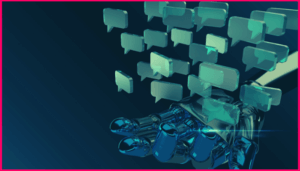How Grocers Can Capitalize on AI
Reading Time: 10 Minutes
If you’re like me, when you think about grocery’s artificial intelligence (AI), you think about grocery list apps, smart shopping carts, automated checkouts, or ChatGPT’s ability to create a specific menu based on my input. There’s so many applications for artificial intelligence to help retailers create value and improve productivity.
AI has changed the grocery game. In grocery, the use of AI will grow 400% by 2025. Generative AI tools could bring $1.9 trillion fiscal impact to the grocery industry through 2029 says new research from IHL Group.
AI automation is a must-have for grocery retailers.
What is AI?
AI can help make search more personalized and relevant. AI can help customers build their basket faster because it understands buying patterns. AI can capture, compare, and optimize millions of price variations, assortment differences, and promotions… then recommend actions to maximize profit.
Artificial intelligence is the science of making machines that can think like humans. Unlike humans, AI can process huge data sets then identify patterns to enhance operations.
At Bungee Tech, we think about AI in terms of everyday category management excellence and retail performance.
With AI, we’re able to collect billions of data points from ecommerce sites, accurately link those products together across the competitive landscape, then offer you a crystal-clear picture of the competitive landscape so you can strategize on price, promotion, and assortment strategies.
Grocery AI for Pricing
Beyond the in-store applications, AI can help grocers understand the pricing landscape, set smart rules, and optimize the pricing strategy. Automation will enable streamlined workflows and business growth.
AI for pricing starts with harnessing retail competitive intelligence. For pricing optimization, you need to first capture, match, analyze, and understand millions of data points across your competitive landscape.
AI algorithms dynamically collect details on your highest priority products to provide details on price per unit, average prices, and promotional strategies. Employing machine learning models for product matching means you can ensure accurate comparisons between products (even private labels or fresh category items).
An AI-driven pricing approach improves competitiveness, builds loyalty, and maximizes your margins.
“The potential of artificial intelligence in grocery is tremendous,” Matt O’Grady, president of Americas for dunnhumby says. “Although the trust in AI is far from widespread, grocers should bear in mind it only took ChatGPT two months to hit 100 million users, making it one of the fastest growing computer applications ever.”
Common Grocery AI Use Cases
According to Honeywell, nearly 6 in 10 retailers plan to adopt AI, machine learning, and computer vision technologies over the next year to enhance the shopping experience offered in stores and online.
AI has the power to elevate the customer’s shopping experience. It will bridge the gap between online and offline activities.
A few ways grocery retailers are using AI today:
Quality Control:
Grocery retailers use AI software for food quality inspection. Grocery retailers are implementing computer vision systems to visually inspect products, ensuring they meet quality standards and identifying defects in real-time.
Personalization:
Grocery retailers use AI software for customer loyalty. Machine learning algorithms then create personalized recommendations for shoppers, suggesting products based on past purchases, browsing history, and demographic information.
Shelf Management:
Grocery retailers use AI software to optimize product placement. Algorithms analyze real-time data to assess shelf conditions, detect out-of-stock items, and recommend restocking strategies.
The ripple effect of these advancements?
Retailers gain the ability to boost operational efficiency, be competitive, and focus on strategic growth initiatives.
Automation Creates Growth
Independent grocers account for a third of all grocery sales, but largely rely on manual processes to manage assortment, monitor promotions, and track pricing. These manual processes are inefficient and error prone.
This year, grocery retailers are spending money to drive efficiency:
- 83% of grocers will increase their spending on digital technologies.
- 74% of grocers will experiment with AI use cases.
- 74% are looking for AI capabilities when considering new software.
- 81% think AI will have the most impact on merchandising.
“In the dynamic landscape of the grocery retail industry, automation isn’t just a convenience; it’s the heartbeat of efficiency,” explains Rajat Nigam, CEO and founder of Bungee Tech.
He adds, “The seamless integration of AI-driven automation is the game-changer that turns data into a competitive advantage.”
The Future is Here
By incorporating AI into price comparison, rule creation, and pricing strategy optimization, grocery retailers can enhance competitiveness, increase efficiency, and maximize revenue.
The future of pricing in grocery retail will be optimized, tech-driven, and customer-centric.
At Bungee Tech, we’re obsessed with the automation and enhancements that AI offers our grocery retail customers. Our team built and trained our retail-specific multimodal machine learning models on different retail data sets. That means you can automatically match exact, equivalent, or similar products. You can set pricing rules to optimize your strategy.
The Latest Insights – Straight to Your Inbox
Sign up for the Bungee Tech mailing list for actionable strategies, upcoming events, industry trends, and company news.














